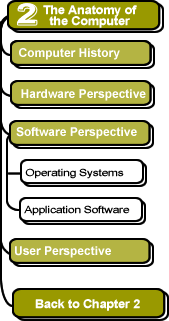

|
Operating Systems: Which Operating Systems Are Available Today?
Operating systems are often associated with a specific microprocessor, but not always. Here's a brief overview of some currently available operating systems.
| Operating system | Manufacturer | Microprocessor(s) it runs on |
|---|---|---|
| Windows | Microsoft | Intel x86 architecture (80386, 80486, Pentium-class) |
| OS X | Macintosh | G3, G4, G5 |
| PalmOS | Palm | Palmtop Organizers |
| Linux | volunteer group | Intel x86 architecture, PowerPC, SPARC |
| Solaris | Sun Microsystems | Sun SPARC, Intel x86 |
Microsoft has produced several versions of its Windows operating systems, including Windows 3.1, Windows 95, Windows 98, Windows ME, Windows NT, Windows 2000, and Windows XP. The last two listed are more robust, more secure operating systems, which provide better (but not foolproof) protection against system crashes, viruses, and so forth. On the other hand, it is more difficult to get device drivers (special software necessary when adding extra hardware to a machine) for these operating systems. Also, many games are not available for these OSes because the games cannot operate under the extra restrictions imposed by the OS.
Linux and Solaris are variants of the UNIX operating system, which was developed at Bell Labs in the 1970s. This operating system used a command-line interface and was designed to support many users on a single machine at one time (using multitasking to run many programs simultaneously). A graphical user interface (GUI) was developed called X-Windows, and this GUI is available on almost all UNIX variants. Linux is an interesting case, because the source code is freely available on the Internet. The core part of the OS (called the kernel) was originally developed by Linus Torvalds as a research project. He released it to the public domain, and now a veritable army of volunteers continues to develop and maintain the operating system, working mainly via the Internet. Several companies package the Linux operating system into "distributions," such as SuSE. The companies charge a fee for this service, but many users willingly pay for the distribution because it makes the job of installing and using the Linux operating system much easier.
![]()
![]()
These pages were written by Steven H. VanderLeest and Jeffrey Nyhoff and edited by Nancy Zylstra
©2005 Calvin University (formerly Calvin College), All Rights Reserved
If you encounter technical errors, contact computing@calvin.edu.